For each language, a series of tables is given to show the reflexes of the Proto-Algonquian consonant clusters in that language. The tables are organized according to the first consonant in the cluster (i.e. the coda consonant). Within each table, Proto-Algonquian clusters are shown in grey text and the reflex of each cluster is shown below it in black text.
Each cluster chart is followed by expository notes; the charts themselves are based on the sources cited in these notes.
Note: I compiled this material and created the cluster charts during my PhD studies in 2011, and there are aspects of the content and presentation that could likely be improved.
Contents
- Proto-Algonquian
- Central languages: Meskwaki, Miami-Illinois, Shawnee, Menominee, Ojibwe, Cree
- Eastern languages: Proto-Eastern Algonquian, Mi'kmaq, Western Abenaki, Massachusett, Quiripi, Munsee Delaware, Nanticoke
- Plains languages: Cheyenne, Proto-Arapaho-Gros Ventre, Arapaho, Gros Ventre, Nawathinehena, Blackfoot
Proto-Algonquian
*NC clusters
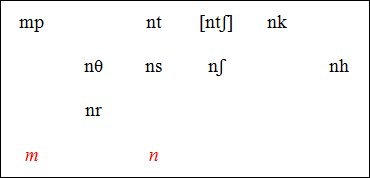
- *nh is not in Bloomfield 1946, but was posited by Hockett (1964: 242) and accepted by Pentland (1979: 368) (who is "as reluctant as Hockett" to posit it).
*hC clusters

- *Hm is not in Bloomfield 1946. The phonetic value of the first consonant could be either *hm or *ʔm (Goddard 1974: 322). Pentland suggests there may also be *Hn (*hn/*ʔn) and observes that in some languages, *nθ/*nr act as if they had become *ʔn (Pentland 1979: 365, 380). Pentland also suggests that the reconstruction with *ʔ is more likely. Goddard (2007) instead argues for *hm.
- Following Pentland, the charts on this page treat the *Hm cluster as belonging to the *ʔC series, although this choice should not be read as an endorsement of Pentland's view.
- Pentland (1979: 369) suggests that *hC clusters developed from a series of pre-PA aspirated segments that functioned as single consonants.
- *hp is extremely rare (Pentland 1979: 369).
*ʔC clusters (includes *xC)
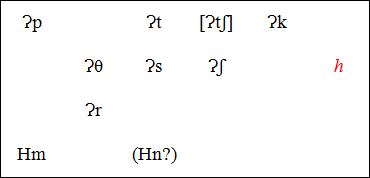
- *ʔ (Bloomfield's *q) is found only as the first (coda) element of a cluster, never on its own. It arose from any underlying plosive (*p, *t, *k) before another consonant (see Meeussen 1959, Pentland 1979: 373).
- *ʔp and *ʔk are Bloomfield's (1946) *xp and *xk, the only members of his *xC series, which is in complementary distribution with the *ʔC series (*x before peripheral consonants, *ʔ before coronal consonants). Pentland (1979) suggests that the two series "probably derive from the same sources" (380) and can be written as a single series (382).
- For *Hm, see the notes on the *hC chart above.
- Bloomfield also posited a *tʃC series with two members: *tʃp and *tʃk. Examples are "few and sparsely attested", and in most cases, the reflexes are the same as for *xp, *xk (Pentland's *ʔp, *ʔk) (Pentland 1979: 382). According to Pentland, reflexes for *tʃp are clearly found only in Menominee, and reflexes of *tʃk in the other languages are "none too regular" (383). Pentland concludes that *tʃp and *tʃk "probably do not represent a genuine set of correspondences" (384), instead resulting from reshaping and other phenomena. The charts on this page follow Pentland in not recognizing a separate *tʃC series.
*SC clusters (*ʃC, *θC, *sC/rC)
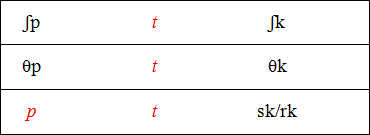
- *θp was not in Bloomfield 1946.
- *ʃt was also postulated by Bloomfield, but Pentland (1979) argues against it.
- The Eastern Algonquian languages show that *θk was distinct from *xC/ʔk (Siebert 1941); this is the only major PA distinction that cannot be reconstructed from Bloomfield's four central languages (Cree, Meskwaki, Ojibwe, Menominee).
- Bloomfield's *çk is suggested to actually be either *sk or *rk by Pentland (1979); Goddard (1994) suggests *rk.
Central languages
Meskwaki
All Meskwaki reflexes in the charts below are from Bloomfield 1946 for now. Some of the gaps can be filled in from later sources.
*NC clusters
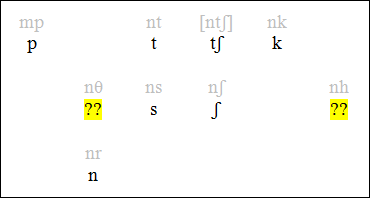
*hC clusters
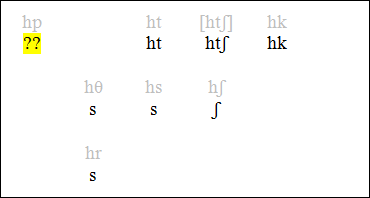
*ʔC clusters (includes *xC)
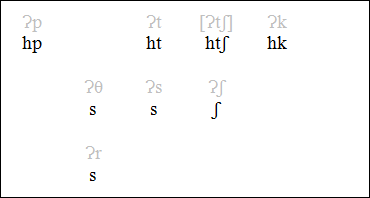
*SC clusters (*ʃC, *θC, *sC/rC)
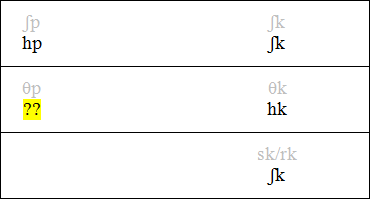
Miami-Illinois
*NC clusters
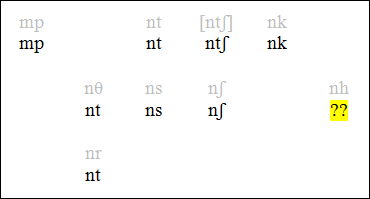
Notes from Costa 1991:
- Consonants are voiced after nasals (as in Ojibwe and Delaware).
- /n/ in modern /ns, nʃ/ tends to delete, with compensatory vowel nasalization and retained voicing of the following consonant.
- The *nθ/*nr clusters develop differently, becoming /nt/ (whereas *θ, r on their own become /r/, later /l/).
- Retention of *NC is shared with Ojibwe (and also Delaware).
*hC clusters

Notes from Costa 1991:
- *hC and *ʔC clusters fall together.
- /hs, hʃ/ are often [sː, ʃː], especially after front vowels and word-initially.
- Clusters in *-θ/*-r develop differently: *ʔθ, ʔr, hθ, hr > /hs/, and *nθ, *nr > /nt/, while single *θ, *r > /r/ (later /l/).
*ʔC clusters (includes *xC)
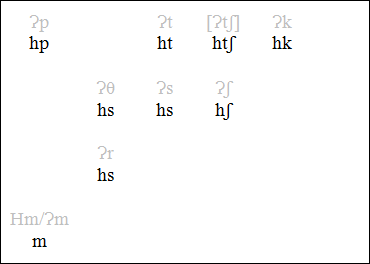
Notes from Costa 1991:
- *hC and *ʔC clusters fall together.
- /hs, hʃ/ are often [sː, ʃː], especially after front vowels and word-initially.
- Clusters in *-θ/*-r develop differently: *ʔθ, ʔr, hθ, hr > /hs/, and *nθ, *nr > /nt/, while single *θ, *r > /r/ (later /l/).
- The merger of *ʔθ, ʔr, hθ, hr is shared with Ojibwe-Potawatomi, Meskwaki-Sauk-Kickapoo, and Shawnee (the "Eastern Great Lakes" group, Rhodes 1988 cited in Costa 1991).
*SC clusters (*ʃC, *θC, *sC/rC)
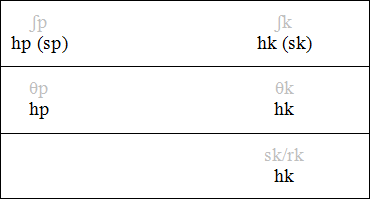
Notes from Costa 1991:
- In the earliest records, *ʃp, *ʃk are /sp, sk/, but they later become /hp, hk/, falling together with the reflexes of the *θC clusters and *sk/rk.
- Retention of *ʃp is shared with Ojibwe-Potawatomi and Shawnee, but not Meskwaki.
- Retention of *ʃk/*rk contrast (in early times) is shared with Cree, Menominee, and Delaware, and only with Ojibwe-Potawatomi in the Eastern Great Lakes group.
Shawnee
*NC clusters
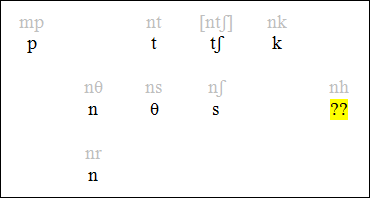
Notes from Pentland 1979:
- Fell together with single consonants (mostly).
- We expect *nr, *nθ > Shawnee /l/, not the attested /n/, since normally an NC cluster simply loses N in Shawnee.
- The reflexes of *ns and *nʃ undergo the same chain shift as *s and *ʃ.
*hC clusters
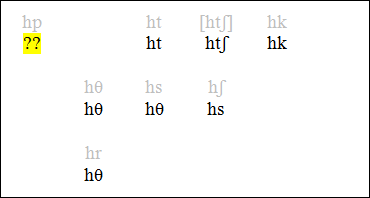
Notes from Pentland 1979:
- Fell together with the *ʔC series.
- Prior to the fricative chain shift, Shawnee /hθ, hs/ would have been /hs, hʃ/ (so the original Shawnee reflex of *hθ was /hs/).
- Phonetic values: /hp, ht, htʃ, hk, hθ, hs/ are [ʔp, ʔt, ʔtʃ, ʔk, ʔθ, ʔʃ] (Pentland 1979).
*ʔC clusters (includes *xC)
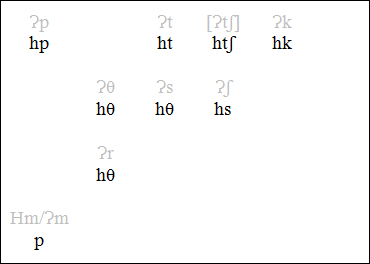
Notes from Pentland 1979:
- Fell together with the *hC series.
- Prior to the fricative chain shift, Shawnee /hθ, hs/ would have been /hs, hʃ/ (so the original Shawnee reflex of *hθ was /hs/).
- Phonetic values: /hp, ht, htʃ, hk, hθ, hs/ are [ʔp, ʔt, ʔtʃ, ʔk, ʔθ, ʔʃ].
- According to Pentland, PA *ʔm is underlying *pm, which metathesized to *mp in Shawnee, thus usually behaving like PA *mp.
*SC clusters (*ʃC, *θC, *sC/rC)
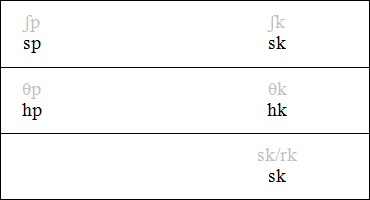
Notes from Pentland 1979:
- *θC clusters fell together with *hC, *ʔC.
- /hp, hk/ are phonetically [ʔp, ʔk].
- /sk/ is phonetically [(ʔ)ʃk].
Menominee
All Menominee reflexes in the charts below are from Bloomfield 1946 for now. Later sources should also be checked.
*NC clusters

Complete merger with the hC set.
*hC clusters
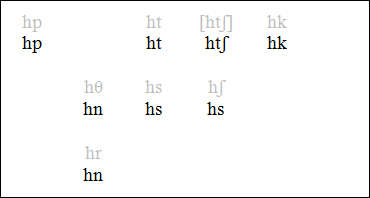
Complete merger with the NC set.
*ʔC clusters (includes *xC)
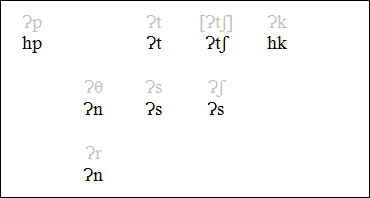
- Clusters whose second member is peripheral (i.e. non-coronal, ʔp and ʔk) merge with the NC/hC reflexes; clusters whose second member is coronal remain distinct, retaining the glottal stop.
- Bloomfield set the peripherals up as a separate *xC series in complementary distribution with the *ʔC series. Pentland (1979: 382) proposes that they can be combined.
- Only Menominee treats the two sub-series differently (Pentland 1979: 380).
*SC clusters (*ʃC, *θC, *sC/rC)
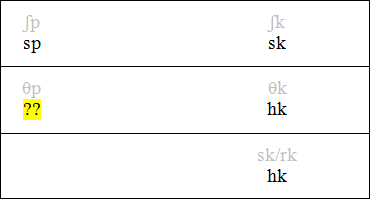
Ojibwe
All Ojibwe reflexes in the charts below are from Bloomfield 1946 for now. Later sources should also be consulted.
I am rendering Bloomfield's <čč> as <ttʃ>.
*NC clusters

*hC clusters
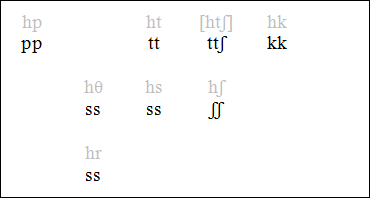
Falls together with the *ʔC series.
*ʔC clusters (includes *xC)
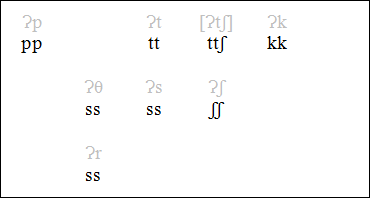
Falls together with the *hC series.
*SC clusters (*ʃC, *θC, *sC/rC)

Cree
Overall notes from Pentland 1979:
- *-tʃ clusters (*ntʃ, *htʃ, *ʔtʃ) usually fall together as /htʃ/, but become /stʃ/ in Central Manitoba Swampy.
- *-s clusters (*ns, *hs, *ʔs) fall together as /s/.
- *-ʃ clusters (*nʃ, *hʃ, *ʔʃ) fall together as /ʃ/, but /s/ in dialects that have merged *ʃ with /s/.
- *-r clusters (*nr, *hr, *ʔr) fall together in all dialects, but the reflex depends on the reflex of *r.
- /hp, ht, hk/ may be realized as [hp, ht, hk], [ːp, ːt, ːk], [ɸp, θt, xk], or [ɸ/f, θ, x].
*NC clusters
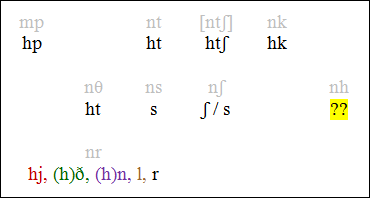
- Exceptionally, *nr > /h/ when in an inflectional suffix and word-final (Pentland 1979).
*hC clusters
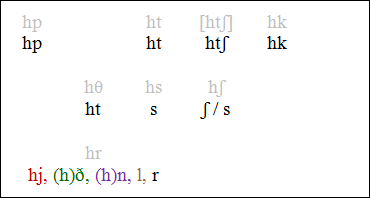
*ʔC clusters (includes *xC)

- *ʔp, *ʔk > /sp, sk/ usually, but /hp, hk/ also occur (Pentland 1979).
- In dialects that merge *ʃ with /s/, *ʔθ, *ʔt become /st/. In dialects that retain the ʃ-s contrast, the reflex is /st/-/ʃt/ in free variation.
- Sometimes Plains and Woods have *ʔtʃ > /stʃ/ instead of the expected /htʃ/, by analogy with *ʔt > st (Pentland 1979: 72).
*SC clusters (*ʃC, *θC, *sC/rC)

Notes from Pentland 1979:
- *ʃp, *θp fall together as /sp/ in dialects that merge *ʃ with /s/, but as /sp/-/ʃp/ (in free variation) in dialects that retain the ʃ-s contrast.
- *ʃk > /sk/ in dialects that merge *ʃ with /s/, and /ʃk/ in dialects that retain /ʃ/.
- *sk/rk usually becomes /hk/, but in Western Woods, it becomes /θk/ or /sk/.
Pentland's account of Cree cluster changes
Pentland (1979) provides an extremely detailed account of the development of consonant clusters in Cree. Some of the important details are gathered here.
Reflexes of stop-final NC and hC clusters
PA NC and hC clusters fall together in Cree. Those ending in *p, *t/*θ, and *k become /hp, ht, hk/, which are realized in various ways:
- Fortis (preaspirated) stops [hp, ht, hk]
- Lenis stops with compensatory lengthening of a preceding vowel [ːp, ːt, ːk]
- Homorganic (non-sibilant) fricative-stop clusters [ɸp, θt, xk]
- Fricatives [ɸ/f, θ, x]
Pentland gives the following information on the distribution of these realizations:
- Fortis stops in Plains and some other dialects. (Though Plains has [xk]-[x] for /hk/ in fast speech.)
- Fricative-stop clusters or fricatives in Swampy. (Also [ːp].)
- Lenis stops with compensatory lengthening in westernmost Swampy dialects and neighbouring Woods dialects.
- Fortis stops intervocalically, fricatives word-finally in Split Lake.
- Fricatives and lenis stops with compensatory lengthening in Shamattawa.
Reflex of *-tʃ clusters
*ntʃ, *htʃ, *ʔtʃ usually fall together as /htʃ/, but become /stʃ/ in Central Manitoba Swampy, where *h before a consonant becomes a homorganic fricative (and *ʃ merged with /s/).
Reflexes of sibilant-final clusters
- *-s clusters (*ns, *hs, *ʔs) fall together as /s/.
- *-ʃ clusters (*nʃ, *hʃ, *ʔʃ) fall together as /ʃ/ in Eastern Swampy, Moose, and Atikamekw (which maintain the /s/-/ʃ/ contrast), and as /s/ in Western Swampy, Woods, and Plains (which have merged *ʃ with /s/).
Reflexes of *-r clusters
- *nr, *hr, and *ʔr fall together in all dialects, but the reflex depends on the reflex of *r.
- For *ʔtʃ in particular, sometimes Plains and Woods have /stʃ/ instead of the expected /htʃ/, by analogy with *ʔt > st (Pentland 1979: 72).
| Dialect | *r | *nr, *hr, *ʔr |
| Plains | /j/ | /hj/ |
| Manitoba Woods | /ð/ | /ð/ |
| Saskatchewan Woods | /ð/ | /hð/ |
| Swampy | /n/ | /n/ |
| Swampy (one variety) | /n/ | /hn/ |
| Moose | /l/ | /l/ |
| Atikamekw | /r/ | /r/ |
(Exceptionally, *nr > /h/ when in an inflectional suffix and word-final.)
Reflexes of *ʔp, *ʔk (Bloomfield's *xp, *xk)
Most often, *ʔp, *ʔk become /sp, sk/, but /hp, hk/ also occur. Pentland proposes that different dialects originally had different reflexes, which have been obscured by subsequent extensive borrowing:
| Reflexes of *ʔp | Reflexes of *ʔk | |||
| Western (Plains) | /hp/ | Swampy | /hk/ | |
| Northern (Woods) | /θp/ | Woods | /θk/ | |
| Eastern (Moose) | /sp/ | elsewhere | /sk/ | |
Note that Goddard (1994) disagrees with Pentland regarding the treatment of *ʔk; Goddard doesn't think the evidence warrants positing a distinct Swampy treatment of *ʔk (which, as Pentland concedes, would require "massive borrowing" to result in the present-day distribution). Instead, Goddard says the best interpretation is that *ʔk, *θk > Cree-Montagnais /sk/ (distinct from /ʃk/ as in Eastern Swampy and Moose).
Free variation between /sC/ and /ʃC/
In dialects that retain a distinction between /s/ and /ʃ/ (Eastern Swampy, Moose, and Atikamekw), some reflexes show free variation between the two sibilants, where dialects with sibilant merger (Western Swampy, Woods, and Plains) have only /sC/.
- *ʔθ, *ʔt become /st/ in dialects with sibilant merger, but in dialects that retain the ʃ-s contrast, the reflex is /st/-/ʃt/ in free variation.
- *ʃp, *θp become /sp/ in dialects with sibilant merger, but in dialects that retain the ʃ-s contrast, the reflex is /sp/-/ʃp/ in free variation.
This apparently does not apply to *ʃk, which becomes /sk/ in dialects with sibilant merger and /ʃk/ in dialects that retain /ʃ/.
Reflexes of *sk/rk
*sk/rk usually becomes /hk/, but in Western Woods, it becomes /θk/ or /sk/ depending on the speaker.
Historical development of clusters with second element *p, *t, *tʃ, *k, *θ
Pentland sketches the development of these clusters in detail. The charts below are based on Pentland 1979: 81-82, with the addition of a column for his proposed Early Cree forms (p. 81). (Note: PA *xC is essentially an allophone of *ʔC, and Pentland suggests elsewhere that PA *tʃC should usually be collapsed with *ʔC.)
Development of Plains Cree clusters

Development of Swampy and Moose Cree clusters, which is subsequently obscured by borrowing from Plains Cree. The developments are similar to Plains, except the s/ʃ contrast is maintained, and /hC/ occurs in one additional environment.

Development of Woods Cree clusters (somewhat different from Plains, Swampy, and Moose)

Eastern languages
Proto-Eastern Algonquian
Overall note: the following figure summarizes the development of *θ/r clusters.

*NC clusters

- *NC clusters are retained, except for *nθ, *nr, which become */hr/ (Goddard 1980).
- The regular word-final reflex of PA *nr in PEA is */h/ (Goddard 1981: 66).
*hC clusters
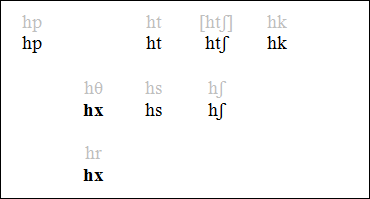
Goddard 1980: *hC clusters are retained, except for *hθ, *hr, which become */hx/ (which may have actually been */hʃ/, but it might have a distinct reflex from */hʃ/ in Massachusett-Narragansett and/or Powhatan).
*ʔC clusters (includes *xC)

Notes from Goddard 1980:
- *ʔC clusters mostly fall together with *hC clusters.
- *ʔp, *ʔk > /*sp, *sk/ instead of /*hp, *hk/.
- *ʔθ, *ʔr behave differently: *ʔθ > */hx/ (as *hθ does), but *ʔr > */hr/ (like *nr). Note that *θ and *r have distinct reflexes here, even though they merged elsewhere.
*SC clusters (*ʃC, *θC, *sC/rC)

Notes from Goddard 1980:
- *ʃC clusters and *rk are retained.
- *θC clusters > */xC/, mirroring the change of *θ to */x/ in laryngeal clusters: *ʔθ, *hθ > */hx/.
Mi'kmaq
Overall note from Hewson 1973: Evidence for the reflexes of *nr, *hr, and *ʔr is "confused and indeterminate". As far as can be determined, *NC, *hC, and *ʔC clusters all fall together.
*NC clusters
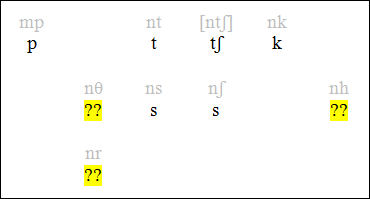
*hC clusters
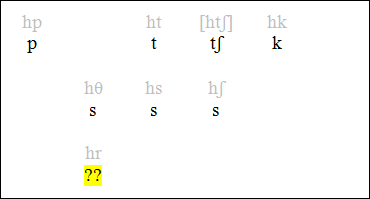
*ʔC clusters (includes *xC)
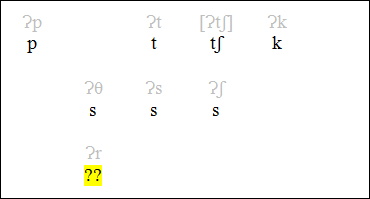
*SC clusters (*ʃC, *θC, *sC/rC)
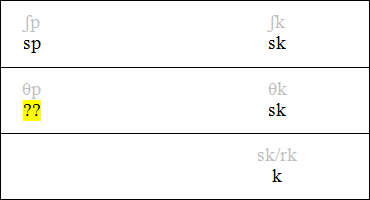
Hewson 1973: Like the Eastern languages in general, Mi'kmaq has different reflexes for *θk (> /sk/) and *ʔk (> /k/).
Western Abenaki
*NC clusters
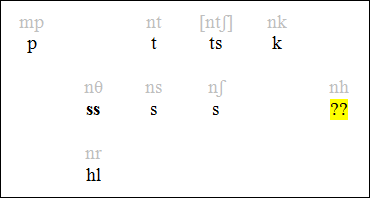
Notes from Warne 1975:
- *NC > C, except *nθ, *nr (which became non-nasal clusters in PEA).
- According to Goddard 1980, PA *nθ, *nr merged to PEA */hr/, but Warne gives different reflexes for each (*nr > /hl/ as expected, but *nθ > /ss/).
*hC clusters
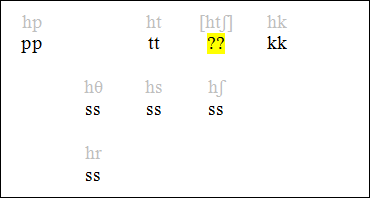
Notes from Warne 1975:
- *hC > CC (a fortis consonant, optionally preaspirated); mostly falls together with the *ʔC series (except *hr).
- PA *hθ, *hr > PEA */hx/ > WA /ss/.
*ʔC clusters (includes *xC)

Notes from Warne 1975:
- *ʔC > CC (a fortis consonant, optionally preaspirated); mostly falls together with the *hC series (except *ʔr).
- I write /tts/ for Warne's /cc/ (p. 29).
- PA *ʔθ > PEA */hx/ > WA /ss/ (same as *hθ/*hr); PA *ʔr > PEA */hr/ > WA /hl/ (same as *nr, and expected for *nθ instead of Warne's /ss/).
*SC clusters (*ʃC, *θC, *sC/rC)

Warne 1975: *rk > /sk/ before a low back vowel (*a, *aː) and /kk/ elsewhere (before other vowels and /w/).
Massachusett
*NC clusters
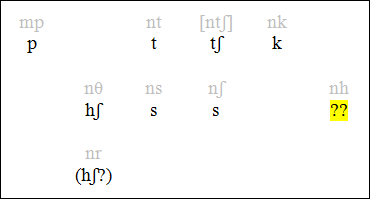
Notes from Goddard 1981:
- PEA *NC > C
- The reflex of *nr is problematic; all relevant examples appear to be obscured by analogical change/reshaping, but we would expect Massachusett /hʃ/.
*hC clusters
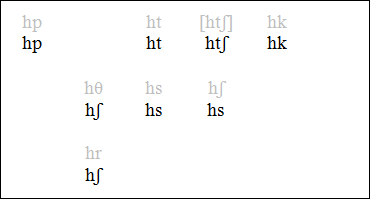
Notes from Goddard 1981:
- Preaspiration is retained.
- *hs/*hʃ fall together as /hs/, but a new /hʃ/ develops from *hθ/*hr (PEA *hx). [Chain shift: *hʃ > hs, *hx > hʃ]
*ʔC clusters (includes *xC)
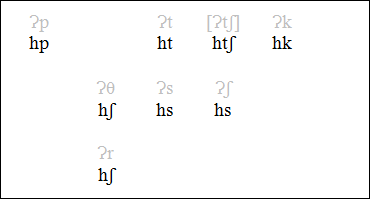
Notes from Goddard 1981:
- Preaspiration is retained.
- Falls together with the *hC series.
- *ʔs/*ʔʃ fall together as /hs/, but a new /hʃ/ develops from *ʔθ/*ʔr (PEA *hx/*hr).
*SC clusters (*ʃC, *θC, *sC/rC)
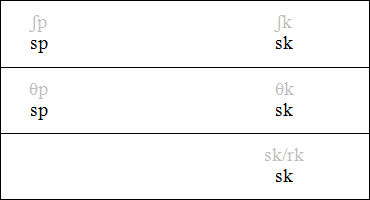
Notes from Goddard 1981:
- First elements all fall together to /s/.
- In this position, /s/ does not contrast with the new Massachusett /ʃ/ phoneme, and there seems to be free variation in the pronunciation of /sk/ [sk~ʃk].
Quiripi
*NC clusters
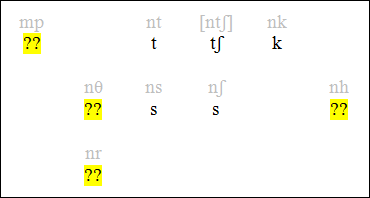
Notes from Rudes 1997:
- *NC > C
- [After the loss of word-final vowels, a resulting *V̆N# drops—parallel to the loss of coda N in clusters?]
*hC clusters
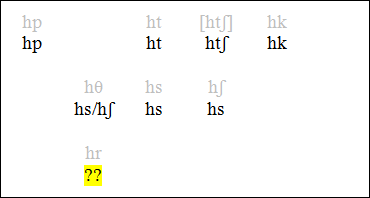
Notes from Rudes 1997:
- *h is maintained.
- In *-θ/*-r clusters, the mainland dialect has /hʃ/ and the insular dialect has /hs/.
*ʔC clusters (includes *xC)
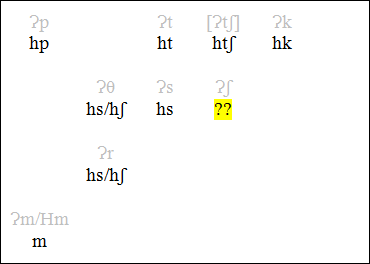
Notes from Rudes 1997:
- Falls together with the *hC series.
- In *-θ/*-r clusters, the mainland dialect has /hʃ/ and the insular dialect has /hs/.
*SC clusters (*ʃC, *θC, *sC/rC)

Rudes 1997: All *-k clusters fall together to /sk/.
Munsee Delaware
*NC clusters
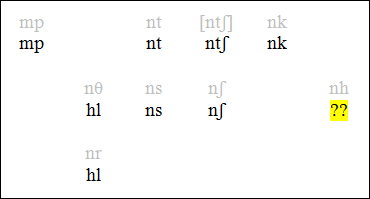
Unchanged from Proto-Eastern Algonquian except for */r/ > /l/ (Goddard 1982).
*hC clusters
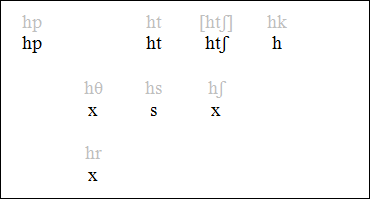
/hp/ is Goddard's (1982) conjecture based on Unami Delaware.
*ʔC clusters (includes *xC)
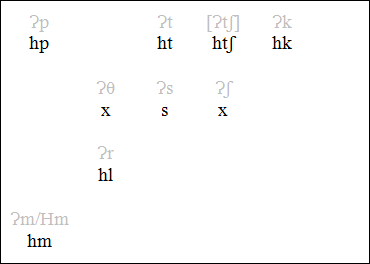
Goddard 1982: In PEA, this series mostly fell together with *hC, except *ʔp, *ʔk, and *ʔr. Munsee merges *ʔp with *hp as well, but keeps *ʔk, *ʔr distinct from *hk, *hr.
*SC clusters (*ʃC, *θC, *sC/rC)
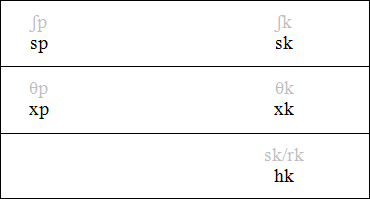
Goddard 1982: In addition to /sp, sk/, /xp, xk/, /hp, hk/ from PA clusters, Munsee also has /ʃp, ʃk/—not as direct reflexes of PA, but rather from diminutive consonant symbolism applied to /sp, sk/.
Nanticoke
*NC clusters
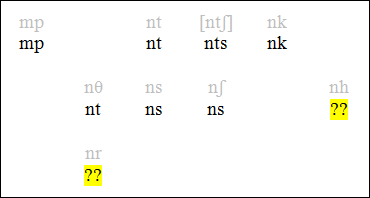
Notes from Pentland 1979:
- *NC remains NC.
- No reflexes of *nr available, but like *nθ, it presumably also becomes /nt/.
- /nk/ is phonetically [ŋg] or [ŋk].
- *nk exceptionally becomes /nt/ word-finally (at least in the locative suffix).
*hC clusters
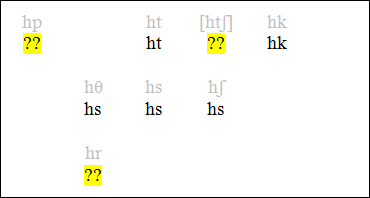
Notes from Pentland 1979:
- The *hC series falls together with the *ʔC series.
- No reflexes for *hr, but presumably it becomes /hs/, as *hθ does.
*ʔC clusters (includes *xC)

Falls together with the *hC series (Pentland 1979).
*SC clusters (*ʃC, *θC, *sC/rC)
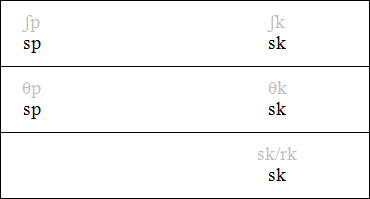
Notes from Pentland 1979:
- *ʃC, *θC, and *sC/rC fall together as /sC/.
- Phonetically, /sk/ is strongly preaspirated: [hʃk]-[ʔʃk]
Plains languages
Cheyenne
The charts show the underlying Cheyenne reflexes for each cluster (Goddard 1988).
*NC clusters
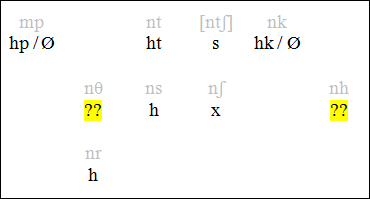
Notes from Goddard 1988:
- Reflexes of *NC fall together with those of *hC.
- For plosives, *NC > /hC/; resulting /hp/ and /hk/ sometimes delete, as do /hp/ and /hk/ from *p, *k.
- For stridents, *NC > /C/, which has the same reflex as single *C.
- For *nr (and *nθ?), the reflex is /h/, which differs from the reflex of *r/*θ as a single consonant (> /t/).
- Phonetics: /hC/ is [hC], except /eht/ is [est] and /ehk/ is [eʃk]. /x/ is [ʃ] when the only flanking vowel, or both flanking vowels, are /e, é/, and is [s] before /ó/.
*hC clusters
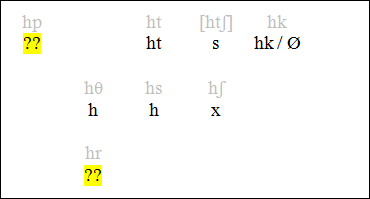
Notes from Goddard 1988:
- /h/ is retained with plosives and lost in other clusters; *C generally has the same reflexes as single *C.
- Reflexes of *NC fall together with those of *hC.
- For plosives, *hC > /hC/; resulting /hp/ and /hk/ sometimes delete, as do /hp/ and /hk/ from *p, *k.
- For stridents, *hC > /C/, which has the same reflex as single *C.
- For *hθ (and *hr?), the reflex is /h/, which differs from the reflex of *r/*θ as a single consonant (> /t/).
- Phonetics: /hC/ is [hC], except /eht/ is [est] and /ehk/ is [eʃk]. /x/ is [ʃ] when the only flanking vowel, or both flanking vowels, are /e, é/, and is [s] before /ó/.
*ʔC clusters (includes *xC)
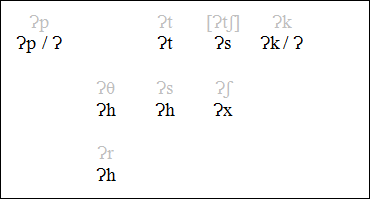
Notes from Goddard 1988:
- Glottal stop is retained in all clusters.
- For plosives, *ʔC > /ʔC/, with optional deletion of /p/ and /k/ (as in general), leaving just single /ʔ/.
- For stridents, *ʔC > /ʔC/, with /C/ developing the same as *C on its own.
- For *ʔr and *ʔθ, the reflex is /ʔh/, which differs from the reflex of *θ, r on their own (> /t/) but is parallel to the /h/ reflex in *nθ/nr and *hθ/hr clusters.
*SC clusters (*ʃC, *θC, *sC/rC)
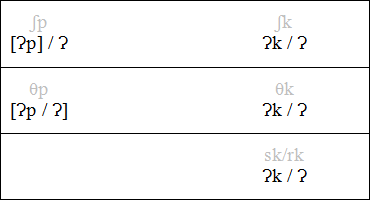
Notes from Goddard 1988:
- Forms in brackets are not attested, but are predicted.
- SC clusters fall together with the reflexes of the corresponding ʔC clusters (*Sp with *ʔp and *Sk with *ʔk).
Proto-Arapaho-Gros Ventre
Reflexes are based on Goddard's (1974) generalizations; Goddard does not provide an explicit list of reflexes.
*NC clusters
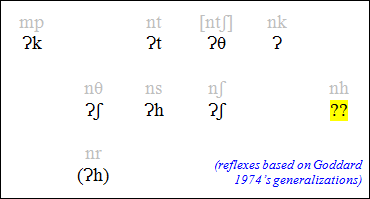
Notes from Goddard 1974:
- Cluster-specific rules: *NC > *ʔC (so the two cluster series fall together); *θ > *ʃ in clusters.
- Global rules that affect NC clusters: *k lost, *p>*k, *tʃ>*θ, *s>*h and *r>*h postconsonantally.
- Goddard found no examples for *nr, so the reflex is hypothetical.
*hC clusters
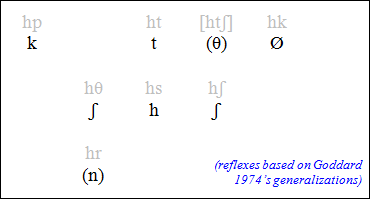
Notes from Goddard 1974:
- Cluster-specific rules: *θ > *ʃ in clusters, then *hC > *C.
- Resulting *C then develops as usual: *k lost, *p>*k, *tʃ>*θ, *s>*h non-initially, *r>*n postvocalically.
- In the end, all *hC clusters have become PAGV single consonants (or Ø).
- Goddard found no examples for *htʃ and *hr, so the reflexes are hypothetical.
*ʔC clusters (includes *xC)
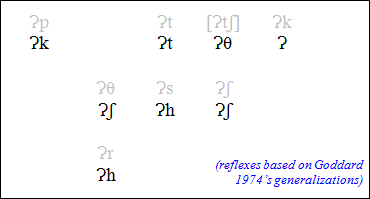
Notes from Goddard 1974:
- *ʔC clusters retain *ʔ.
- Cluster-specific rule: *θ > *ʃ in clusters.
- Global rules that affect *ʔC clusters: *k lost, *p>*k, *tʃ>*θ, *s>*h and *r>*h postconsonantally.
- *NC clusters fall together with the *ʔC series (as does the *rk cluster).
*SC clusters (*ʃC, *θC, *sC/rC)
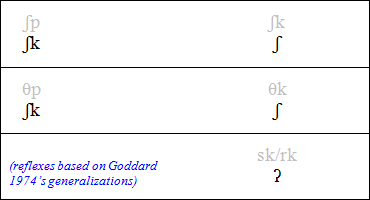
Notes from Goddard 1974:
- *rk falls together with *nk and *ʔk to become *ʔk.
- Cluster-specific rule: *θ > *ʃ in clusters. As a result, *θC and *ʃC fall together.
- *k is lost everywhere and *p > *k.
Arapaho
The starting point in this chart is Proto-Arapaho-Gros Ventre rather than Proto-Algonquian:
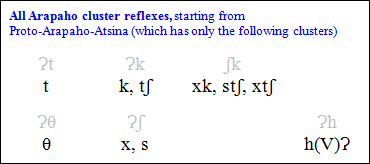
Notes from Goddard 1974:
- Proto-Arapaho-Gros Ventre had only the set of clusters shown in the chart.
- *ʔh metathesized to /hʔ/, sometimes with an intercalated vowel /hVʔ/.
- *ʔ was lost in all other clusters, with compensatory lengthening of a preceding non-postvocalic vowel.
- The resulting single consonants had the same evolution as inherited *C.
- There are few examples of PAGV *ʃk; in addition to the expected /xk/ and /stʃ/ reflexes, we also find /xtʃ/.
Gros Ventre
The starting point in this chart is Proto-Arapaho-Gros Ventre rather than Proto-Algonquian:
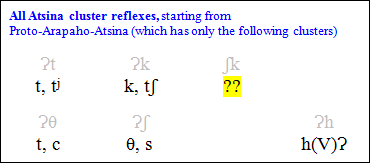
Notes from Goddard 1974:
- Proto-Arapaho-Gros Ventre had only the set of clusters shown in the chart.
- *ʔh metathesized to /hʔ/, sometimes with an intercalated vowel /hVʔ/.
- *ʔ was lost in all other clusters, with compensatory lengthening of a preceding non-postvocalic vowel.
- The resulting single consonants had the same evolution as inherited *C.
Nawathinehena
Overall notes on Nawathinehena /hʔ/ (Pentland 1979):
- Phonetically either [h] or [hV̆ʔ] with a copy of the preceding vowel.
- From *ʔθ, *ʔr via intermediate stage *ʔh followed by metathesis to /hʔ/ (Pentland 1979: 197).
- From *θk, *hk, which merged as *hk; regular loss of *k gave fortis *h, which became /hʔ/.
- From *hθ, *hs, *hʃ, and *ns.
Overall notes on Nawathinehena /ʔs/ (Pentland 1979):
- Phonetically either preaspirated [xs] or [ʔV̆xs] with a copy of the preceding vowel.
- From *nʃ, *ʔʃ (by regular change of *ʃ > /s/), *ʃk (by regular loss of *k, which left fortis *ʃ, equivalent to *ʔʃ).
Overall notes on Nawathinehena /ʔt/ (Pentland 1979):
- Phonetically either preaspirated [xt] or [ʔV̆xt] with a copy of the preceding vowel.
- From *ʔt, *ʔs (by regular merger of *s with *t), *sk/rk (by regular loss of *k, which left fortis *s, equivalent to *ʔs).
*NC clusters

*hC clusters
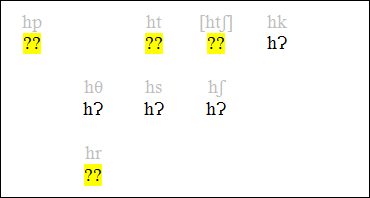
*ʔC clusters (includes *xC)
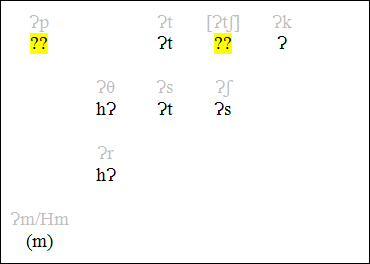
Notes from Pentland 1979:
- Nawathinehena /ʔ/ from *ʔk after the regular loss of *k.
- *ʔm > /m/ probable, but data is not sufficient.
*SC clusters (*ʃC, *θC, *sC/rC)
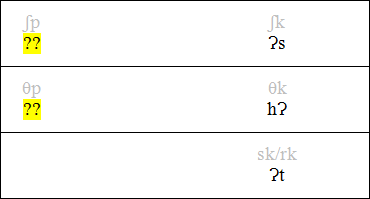
Blackfoot
Berman (2006) states that the first element of all clusters becomes Blackfoot /x/ (which is /h/ for Berman), or /ss/ with shortening of the preceding vowel after PA *i(ː) and initial *e. Therefore, all cluster series fall together into a single set of /xC/~/ssC/ clusters. The reflexes shown in the charts below are conjectural, combining /x/ with the reflex that *C has when it occurs on its own.
*NC clusters
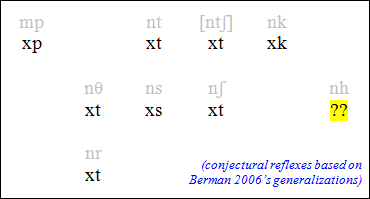
*hC clusters
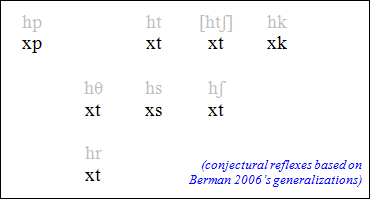
*ʔC clusters (includes *xC)
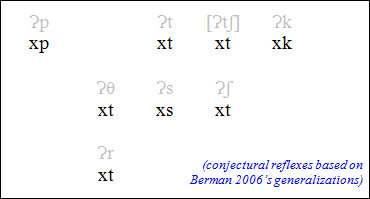
*SC clusters (*ʃC, *θC, *sC/rC)
